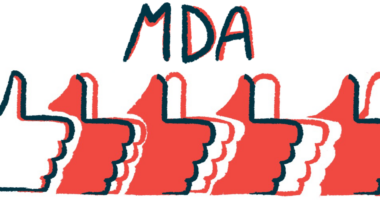1st DMD patient dosed in trial of PepGen’s exon 51-skipping therapy
Phase 2 trial testing safety, efficacy of PGN-EDO51 in 10 male patients

Dosing has begun in a Phase 2 clinical trial evaluating PepGen‘s PGN-EDO51 — a treatment candidate for Duchenne muscular dystrophy (DMD) patients amenable to exon 51 skipping.
The trial, called CONNECT1-EDO51 (NCT06079736), will evaluate the safety and preliminary efficacy of the experimental therapy in about 10 patients, with early results expected by mid-year, PepGen stated in a company press release. The trial is open-label, meaning that both researchers and participants know the medication being tested.
“We are pleased to have dosed the first patient in our CONNECT1-EDO51 clinical trial, which marks another milestone in our commitment to developing therapies with the potential to truly improve the lives of people living with DMD,” said James McArthur, PhD, president and CEO of PepGen.
Escalating doses of PGN-EDO51 — currently set at three levels — will be given to trial participants as safety data is assessed.
Trial follows one that tested PGN-EDO51 in healthy volunteers
People with DMD carry defects in their DMD gene, resulting in a lack of functional dystrophin, a protein essential for the structure and integrity of muscle fibers. Without dystrophin function, patients experience progressive muscle degeneration marked by muscle weakness and atrophy, or wasting.
Like all genes that encode proteins, the DMD gene contains exons — segments along the DNA strand that provide instructions for making proteins. In between exons are other segments called introns, which are removed, or spliced out, to generate the mature code containing only exons that are then translated into a protein.
Mutations that cause DMD lead to the loss of one or more exons after the introns are removed, resulting in a dystrophin protein that doesn’t function or is missing entirely.
Exon skipping is a DMD treatment strategy in which small strands of DNA or RNA, called oligonucleotides, mask, or skip, an exon. This allows the remaining exons to fit together such that a shorter, but still functional, dystrophin protein is produced.
PGN-EDO51 works by skipping over exon 51 in the DMD gene, which may benefit about 13% of all DMD patients, according to PepGen.
Exondys 51 (eteplirsen) is another exon 51 skipping therapy, developed by Sarepta Therapeutics, which was approved in the U.S. in 2016.
PepGen uses its proprietary platform Enhanced Delivery Oligonucleotide, or EDO, to deliver PGN-EDO51 into the muscles. The company says this will lead to more efficient exon-skipping than other approaches.
In preclinical studies using non-human primates, PGN-EDO51 was more effective at skipping exon 51 compared with another oligonucleotide therapy, which may translate to higher levels of dystrophin production in patients, according to PepGen.
The company launched a Phase 1 study in Canada last year to evaluate PGN-EDO51 in 32 healthy volunteers. Data from the single-ascending dose trial showed the therapy, administered by intravenous or into-the-vein infusion, was generally well tolerated up to doses of 15 mg/kg.
PGN-EDO51 also generated the highest levels of exon 51 skipping following a single dose compared with publicly available clinical data for other exon 51 skipping methods. About one month after a 10 mg/kg dose, the average level of exon 51 skipping was 1.4%, and the peak level reached 3.8%. Overall, all participants demonstrated exon skipping.
CONNECT1-EDO51 will evaluate multiple ascending doses of PGN-EDO51 in male DMD patients, ages 8 and older, amenable to exon 51 skipping.
Based on the levels of exon skipping achieved following a single dose of PGN-EDO51 in our Phase 1 healthy volunteer trial, we are looking forward to our initial planned data readout in DMD patients at the 5 mg/kg PGN-EDO51 dose level for CONNECT1-EDO51 in the middle of 2024.
As part of the protocol, the starting dose will be 5 mg/kg, then increased to 10 mg/kg. Further dose increases in additional patients will be determined based on the evaluation of safety data of prior doses, as assessed by a committee.
After four monthly doses, levels of the oligonucleotide within muscles will be measured, as well as the extent of exon skipping and dystrophin protein production.
“Based on the levels of exon skipping achieved following a single dose of PGN-EDO51 in our Phase 1 healthy volunteer trial, we are looking forward to our initial planned data readout in DMD patients at the 5 mg/kg PGN-EDO51 dose level for CONNECT1-EDO51 in the middle of 2024,” McArthur said.
PepGen is using its EDO platform to develop a number of exon-skipping therapies for DMD, including those for patients amenable to skipping exons 53 (PGN-EDO53), 44 (PGN-EDO44), and 45 (PGN-EDO45). So far, preclinical studies have generated promising results.
Lastly, the company also is developing a therapy called PGN-EDODM1 for myotonic dystrophy type 1 (DM1), a subtype of muscular dystrophy that begins during adulthood. In October 2023, the U.S. Food and Drug Administration lifted a clinical hold on testing this therapy. Dosing in a Phase 1 study, called FREEDOM-DM1, began prior to the close of the year.







